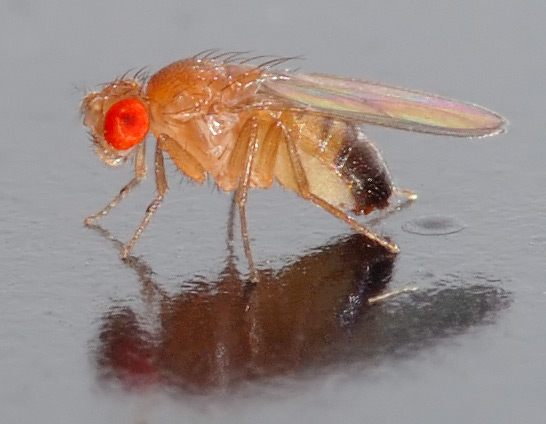Ben - Now, you've been looking at a new way to make insects survive some very extreme conditions.
Phillip - Yes, this is a polymer nano-suit that will protect insect or insect larvae from the high vacuum and electron beams inside a scanning electron microscope.
Ben - So, we call it a polymer nano-suit. It does involve actually putting a  suit on the insect before we put it in the machine.
suit on the insect before we put it in the machine.
Phillip - Well yes, but that's not how it was discovered. The original discovery was made because a particular kind of larvae - Drosophila which are the fruitflies that we're very familiar with from a lot of biological studies - actually naturally produce a material on their surface that when it's bombarded with electron beam, crosslinks to make a natural polymer nano-suit.
And thats what Takahiko Hariyama at Hamamatsu University found when they put these Drosophila larvae into their SEM, they expected them to die and dehydrate, all their water to evaporate. But actually, they found that the larvae were wiggling around and moving for over an hour and if you want to see it, you can look at the video on the Chemistry World website. We've got some videos of the Drosophila larvae wiggling around in the microscope.
Ben - So, why do the larvae do this? Do we have any idea why they would protect themselves from conditions that they're simply never going to encounter on Earth?
Phillip - Well, it's not necessarily likely to be designed for that purpose or evolved for that purpose. It's just a protective kind of sticky layer that protects them as they develop as larvae. It only becomes a nano-suit actually when it's bombarded with the electron beam. So, if you put them into a high vacuum without the electron beam, they do dehydrate, shrivel up and die. But when you have the electron beam there, the energy and the electrons in the beam can make whatever is in the molecules in the extracellular substance crosslink conforms kind of polymer.
The interesting thing is that the group found that if you take a similar molecule called Tween which is a surfactant that's used quite extensively in biology. It acts in a very simple way if you dip larvae that don't naturally have this extracellular substance on them into a solution of Tween and put them into the microscope and apply the electron beam, it crosslinks and makes a sort of manmade polymer nano-suit. So you can then look at all sorts of different kinds of larvae and spiders, and crustacean larvae as well. So, they've extended it to look at all sorts of things in much more realistic conditions because of obviously, they're not dessicated and dried out so you can see what these things are actually like and how they move.
Dan - How big a creature could you image in this way?
Phillip - Well, at the moment, what their team has done is mostly sort of larvae of spiders or insects, or whatever. So, these are quite smart. I mean, if you think of a fruit fly, that's a prety tiny thing so the larva is probably even smaller. So I mean, these are still quite small things and if we had bigger things, you'd probably look at them in a different kind of microscope. You wouldn't necessarily need an electron microscope. So, this I think, it's going to be for relatively small things. But I guess in theory, there's not a huge limit to how big a thing you could put in as long as it's covered and fits in the actual equipment.
- Previous Chemical ear defenders
- Next Strange properties observed









Comments
Add a comment